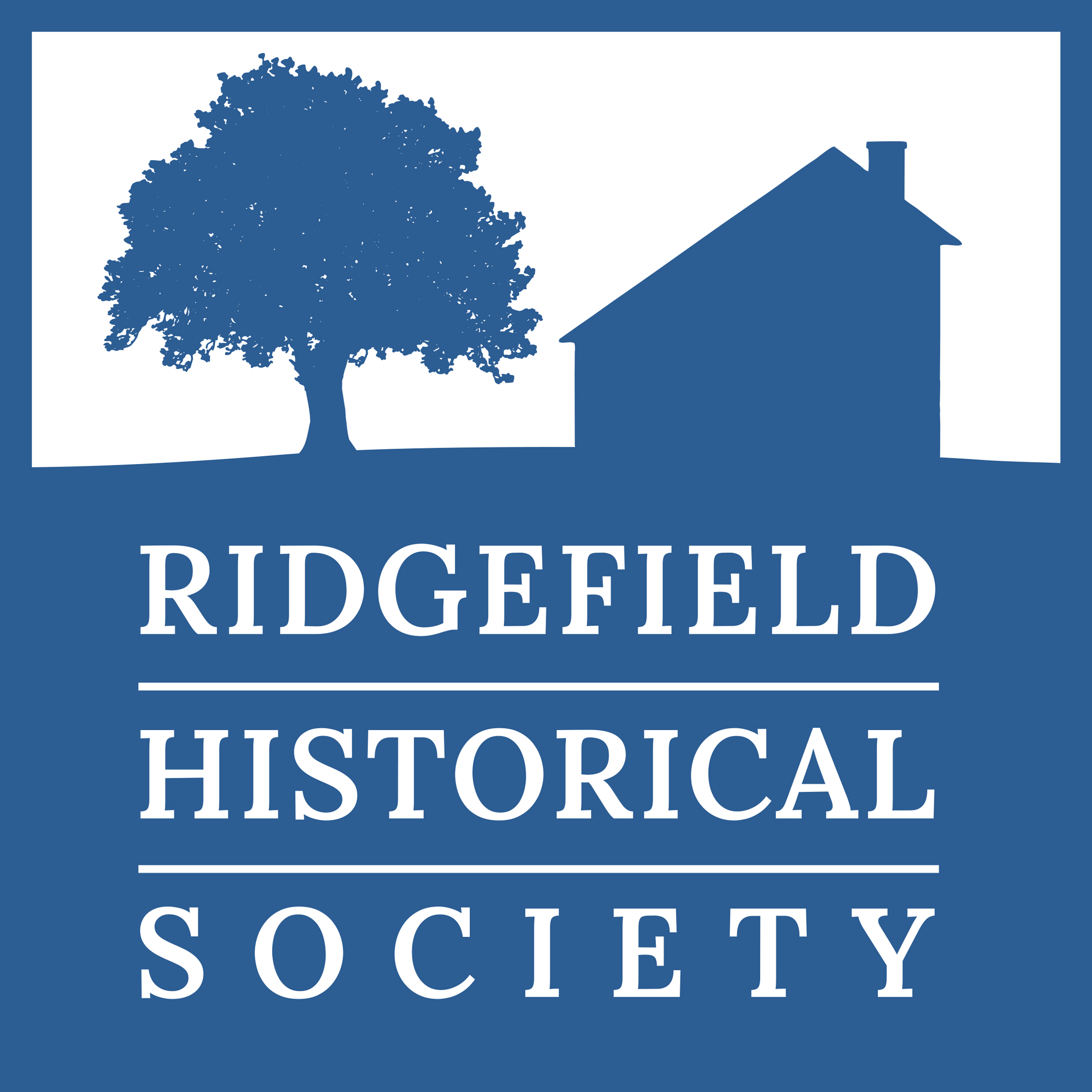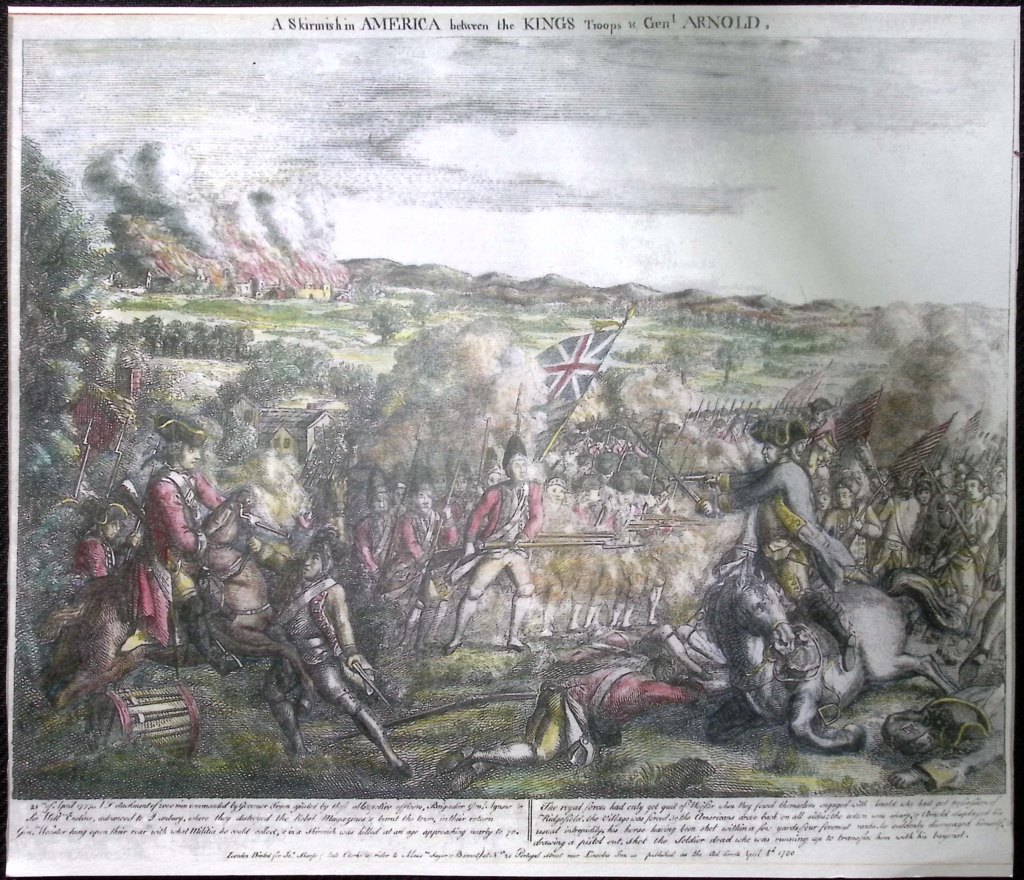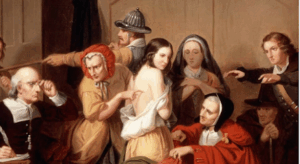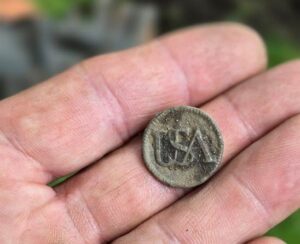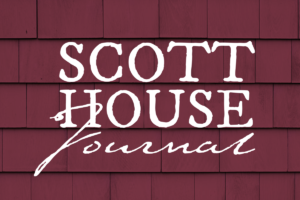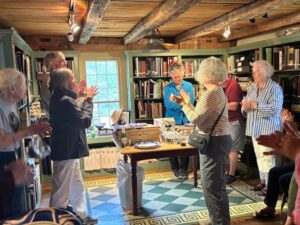The Ridgefield Historical Society Announcement of a Request for Proposals
Battle of Ridgefield: Research and Archaeology Project
Issue Date: September 15, 2024
Due Date: October 31, 2024
Contract Contact: Stephen Bartkus, Executive Director, Ridgefield Historical Society
Overview
The Ridgefield Historical Society (RHS), in partnership with the State Historic Preservation Office (SHPO), seeks to contract with a professional cultural resource management firm, qualified individual, or team to carry out the objectives of an American Battlefield Protection Program Grant, administered by the National Park Service. The tasks associated with the scope of services are intended to provide a comprehensive understanding of the Battle of Ridgefield (Battle) and to promote future preservation and stewardship activities. The currently requested services consist of conducting additional research, archaeological excavations, and preparing a final report of the investigation.
Sealed proposals will be received by the RHS for furnishing the services herein listed. Responses to the RFP can be hand delivered or mailed to the address provided at the end of this document, but all submissions must be received by 4:00 pm on October 31, 2024.
Background
In late 2019, the Battle became the subject of intense interest with the unanticipated discovery of human remains in the basement of a historic house. The house sits near a plaque that reads, “In Defence of American Independence, At the Battle of Ridgefield, April 27, 1777, Died Eight Patriots, who were laid in these Grounds, Companioned by Sixteen British Soldiers, Living their enemies, dying their guests. In honor of service and sacrifice, this memorial was placed for the strengthening of hearts.” All of the recovered individuals are characterized as robust young men. Jacket buttons are currently being conserved, but have not been positively identified with either British troops, Continental Soldiers, or the militia, but all other evidence suggests that these men were casualties of the Battle.
Dr. Walter Woodward, now Connecticut’s State Historian Emeritus stated, “There’s nothing quite like looking down on the skeletons of men hastily buried in shallow Revolutionary War graves to focus one’s attention on questions of war and patriotism and what – then and now – it meant and means to be an American.” RHS and SHPO would like to take this moment of intense public interest to create a stewardship plan for the battlefield. The first step will be understanding the battlefield and putting into context the recently uncovered skeletal remains. The Battle was the only inland engagement of the Revolutionary War fought in Connecticut and is now believed to be the only Connecticut location where fallen soldiers have been recovered from a battlefield.
On the night of April 25, General Tryon had marched his troops, mostly unchallenged, from their landing at Westport to destroy patriot supplies at Danbury. After accomplishing that goal, and following an overnight encampment in Danbury, he directed his men south through Ridgefield, choosing a different route back to the ships waiting off Westport after receiving warning of the massing opposition. On April 27, 1777, the Revolutionary War came to Ridgefield, Connecticut, as some two thousand British and loyalist troops under Major General William Tryon fought patriot soldiers, militia and volunteers, led by Generals David Wooster, Benedict Arnold and Gold Selleck Silliman.
The first engagement in Ridgefield consisted of a surprise rear-guard attack by General Wooster and took place at two locations along the road from Ridgebury to the village. After the first, it was reported that at least two British soldiers had been killed and forty were taken prisoner. General Wooster retreated into the woods. When he returned, he faced a more prepared British force and the General was mortally wounded. The final and main engagement centered on a barricade at the north end of Main Street. Anticipating the British discharge of flanking parties, General Silliman was prepared, but outnumbered three to one. General Arnold gave the order to retreat as he faced the approaching enemy after the barricade was breached. The British troops marched south of the village and camped overnight off Wilton Road West. The Battle is recorded as a success by the British, but it turned the tide of sentiment in Connecticut. The next day, as the British departed, the militia regrouped, but looked very different. Overnight, approximately 500 men from Connecticut and neighboring New York arrived.
As Dr. Woodward recounted: “Three months before shots were fired at Lexington and Concord, the residents of Ridgefield in a town meeting rejected the demands of the First Continental Congress and reaffirmed ‘his Most Sacred Majesty King George III to be our rightful sovereign.’” Days before the war began, pressed by the town’s patriots, Ridgefield voted not to reconsider its pledge of loyalty to the king. According to Dr. Woodward, “British General William Tryon never expected to meet much resistance when he led his troops through here on April 27, 1777, after the burning of Danbury. He even thought a smart show of British military might well bring western Connecticut back into the royal fold.” But the people did resist: citizens and militia made their way to Ridgefield from all over the County by the time Tryon’s men got to Ridgefield. Continental soldiers were reinforced by over 200 local men in this Battle. They sprang into action as a result of the devastating British raid on Danbury and the Battle galvanized support for the patriot’s cause in Connecticut.
Although a number of books have been written about Tryon’s Raid, and the Battle of Ridgefield specifically, further research is needed. This is evidenced by the discovery of the skeletal remains during a small construction project. We know that there were three engagements that comprise the Battle, but the historic extent and the current integrity of the battleground remain unknown. Some of the many questions that have recently arisen from the press and the public are: Were the skeletons those of Patriots or Loyalists or British troops? How did the non-combatant residents of Ridgefield interact with the soldiers? What specifically did the British and Loyalist soldiers learn from the Ridgefield encounters? Who buried casualties from the battle? Where are the other soldiers that died in the Battle buried? While skeletal and artifact analysis is ongoing and may answer some of these questions, only additional research could provide additional answers.
The three engagements that took place on April 27, 1777, covered approximately one-third to half of the entire town, and the ongoing skirmishing from Danbury south through Ridgefield’s center, impacts all Ridgefield residents. Although a few battlefield artifacts have been recovered, such as cannonballs, the Battle has been considered mostly from a historical perspective rather than a tactical or archaeological one. Interpretation has relied on diaries or written accounts of the events. The details of how and where the event unfolded would best be understood through comprehensive, systematic testing of the area, as well as considerations beyond the engagement to include encampments, field hospitals, and the cultural landscape.
Scope of Services
Preservation Goals and Anticipated Outcomes
RHS is partnering with the Connecticut State Historic Preservation Office (SHPO) for their technical guidance and assistance administering the proposed grant. The most effective tool for preserving our state’s important cultural resources is through partnerships. This grant is the second phase of a long-range stewardship project to understand, share, and preserve this nationally important historic event.
The first NPS ABPP grant included goals of conducting pre-inventory research and identifying and documenting probable locations of all engagements and ancillary sites related to the Battle. This completed grant project resulted in several findings that have increased understanding of the battle:
- A historical chronicle of the sustained actions between the British Army under the command of General Tryon and American troops under the command of Generals David Wooster, Benedict Arnold, and Gold Silliman on April 27, 1777 has been established.
- The role of the Westchester County, NY militia has been substantially clarified.
- Disparate eyewitness accounts of the action have been sequenced more comprehensively.
- A more definitive Battle timeline has been established.
- The presence of black soldiers in continental service has been documented, so that their contribution to the War for Independence can be better understood.
- The landscape within the Battlefield boundary may be richer in artifacts than previously thought.
The goal of the second grant is to continue historical research; expand and elaborate understanding of the battle and the individual participants within units with a focus on underrepresented communities; better understand the impact of Loyalists in the Battle; define battlefield boundaries through archaeological means; identify and record areas of integrity; heighten community investment in the project; and assess the eligibility of the battlefield for nomination to the National Register of Historic Places. All of this will contribute to preservation needs and strategies that can’t currently be pursued because of knowledge gaps.
Focus Areas
While our first NPS ABPP Battle of Ridgefield Grant centered on historical research, the current grant primarily focuses on archaeology. One of the most exciting things identified during the previous NPS ABPP Battle of Ridgefield Grant was the documentation of precisely which units were involved in the engagement. This information will allow research into the individuals involved in the event. One of the research opportunities will be to recognize soldiers from underrepresented racial and ethnic groups. It is well known that Connecticut had a sizable number of Native American and African American soldiers on the muster rolls, but now their specific contributions to the Battle can be recognized. The Battle of Ridgefield was important to the State of Connecticut because it fomented support for American patriots and the Revolution. From this perspective, archaeological research will seek to identify the broad range of people from different racial, ethnic, and religious groups within Ridgefield that came together in this sentiment. We will also consider the role women and children from the Town may have played in supporting either side during the Battle and seek greater understanding of the role of the Loyalists in the Battle, and the impact of the Battle on Loyalists.
Archaeological research will be used to develop a more inclusive story of the Battle and the Revolution in Connecticut that will support expanded programming for America 250. Within Ridgefield, the goal will be to create educational and preservation initiatives to raise the visibility and collective understanding of this important battle of the American Revolution.
RHS and SHPO are committed to informing and educating local residents on the significance of the Battle and the importance of preservation. The consultant will need to share their progress and findings with the community, as well as write a monthly update (no more than one page in length and supply related photographs) on research progress for RHS to put on its website and on social media. RHS and SHPO also will sponsor community programs about battlefield preservation with the goal of creating policies for areas under the highest risk of development. An Archaeology Ordinance will be proposed for Ridgefield. The consultant should be prepared to attend and speak at these programs to both provide information and answer questions. The consultant will also deliver three public PowerPoint presentations throughout the project, highlighting key discoveries and featuring the participation and contributions of historically underrepresented groups, including African Americans, Native Americans, and Loyalists in the Battle of Ridgefield and the American Revolution. The consultant will participate in a professional development workshop about Battle of Ridgefield archaeology for Ridgefield town commissioners and staff. The consultant will also participate in two public archaeology day demonstrations at the Ridgefield Historical Society.
It is expected that the hired consultants will meet or exceed Professional Qualifications Standards set by the Secretary of the Interior (Appendix A of 36 CFR Part 61) in the areas of History and Archaeology. At a minimum, a Historian possessing these qualifications will be required for the project and a qualified Archaeologist is strongly recommended. Because this project is intended to be a collaborative effort that engages with the public, independent researchers, and the staff of RHS, the successful respondent will provide examples of having completed similar projects, especially those done in collaboration with volunteers. Access and hands-on involvement in sitework by RHS members and volunteers will be an important component of the project. Close communication and coordination by the consultant with a documentary team who will be filming will also be an integral part of the project.
Tasks, Deliverables, and Schedule
Each task associated with this contract and its deliverables are listed below. The suggested duration for each task also is included, but RHS anticipates that some activities will run concurrently. All deliverables should be comprehensive, well-written, and professional. The number and extent of edits will be dependent on the quality of work received. While the tasks below include one round of edits for the final report, more will be required if the work product is not commensurate with current professional standards. In addition to the tasks below, the consultant should plan on at least one in-person meeting to get the project started and at least three additional meetings with RHS that can be either in-person or remote. An Advisory Committee will be meeting quarterly on Zoom and the consultant will be required to attend each of those meetings and report on project progress. Regular updates and communications regarding the tasks below are an expectation of the contract.
Objectives and Activities
The goals of the grant are to conduct archaeological field work and expand upon and continue previously completed research, as well as continue community engagement efforts in preparation for America 250 celebrations. Research completed during the last ABPP grant made apparent that all is not known about the Battle. The previously completed research revealed important information about the locations of all engagements and ancillary sites related to the Battle of Ridgefield. Limited fieldwork on threatened parcels of land within the battlefield and property owner artifact identification outreach suggests that the battlefield has moderate to high integrity and the potential to yield significant archaeological deposits. As a result, the purpose of the current grant is to focus on specific research questions and conduct site identification and documentation activities to better delineate and improve our understanding of this important battle. Explicit tasks are identified below with anticipated duration, but with the understanding that they likely will proceed simultaneously.
Task 1: Targeted Historic Research (12 months)
The technical report from the prior ABPP grant identified these additional areas of research to focus on:
- Ascertain the location of General David Wooster’s Division following the Second Engagement on April 27, 1777. Their location on the battlefield after Wooster was mortally wounded is not known.
- Determine the extent of fighting that occurred in Ridgefield Village following the Third Engagement. Pinpoint where these actions occurred, and which American forces were involved.
- Identify soldiers from underrepresented racial and ethnic groups that participated in the battle.
- Explore the role of Loyalists on Battle strategy, actions, and outcomes.
- Continue researching military pension records to search for surviving pension materials with any reference to the Danbury Expedition or Ridgefield.
- Expand research for materials related to the Danbury Expedition or Ridgefield in the English National Archives at Kew, Richmond, United Kingdom.
- Define and archaeologically investigate the British campsite location in southern Ridgefield after the village was secured on April 27.
The consultant will explore these research themes and will visit local, state, and national repositories, to locate and, with permission, copy relevant information. While the consultant will be expected to research the first five items, a local researcher will be hired as a subconsultant to retrieve information from the English National Archives. The collected information will be indexed, analyzed, and used to address the above-described research queries to the greatest extent possible.
Task 2: Create a Map of Archaeological Sensitivity Areas (2 months)
The consultant shall create a map of the Battle depicting areas of archaeological sensitivity. Information collected in the previous report regarding prior archaeological investigations, walkover surveys, and property owner interviews will be used to identify areas of known sensitivity. Based on historical research of the engagement and ancillary areas, areas of probable archaeological sensitivity will be estimated. The resulting map should take into consideration modern and historic land use information to determine the potential for preservation. Finally, the consultant should be prepared to field verify any locations that cannot be easily classified using remote techniques.
Task 3: Conduct Property Owner Outreach (2 months)
After the Map of Archaeological Sensitivity Areas is created, the consultant shall select at least four areas for archaeological investigation in consultation with RHS and SHPO. Once these locations are agreed upon, the consultant will procure landowner permission to conduct archaeological investigations. Even for properties that will not be subjected to additional testing, there will be outreach required by consultant to educate property owners about the potential archaeological resources in their care. The consultant, in consultation with the Advisory Committee, will prepare a short handout explaining the nature of archaeological resources, why they are important, and best practices for protecting them from harm.
Task 4: Devise Archaeological Testing Plan and Execute Archaeological Survey (6 months)
Because there are a variety of site types and landforms that comprise the archaeological deposits associated with the Battle, it is expected that the consultant will need to employ a variety of methodologies to recover archaeological information. The consultant should be prepared to excavate a minimum of one hundred 50×50-centimeter shovel test pits, 16 1-meter units, and 12 days remote sensing with a combination of Ground Penetrating Radar and metal detecting. RHS and SHPO would like to allow some flexibility based on the areas identified in the sensitivity map, the research questions to be asked, and landowner permission.
Task 5: Preparation of Final Report (4 months)
A final report will be prepared that describes the methods undertaken to conduct historical research, to create the archaeological sensitivity map, and to complete the archaeological field investigations. The report also will address the identified research questions with new historical narratives about the Battle based on collected data. Finally, the report should include professional recommendations for additional research or archaeological surveys. A draft version will be circulated for review and comment. Once finalized, digital and printed copies will be distributed to RHS and SHPO.
Task 6: Conservation and Curation (1 month)
All artifacts recovered will be cleaned, inventoried, and cataloged by the consultant. The metal artifacts recovered during the archaeological survey will receive specific conservation treatment from the consultant to stabilize and preserve them for the long-term. RHS will be the repository of all artifacts recovered from the archaeological survey. RHS will purchase archival boxes to house the artifacts and will enter the catalog information from the consultant in its PastPerfect collections management database.
Notes:
- It is expected that the consultant will work collaboratively in completing these tasks. This will include working with volunteers and staff of RHS.
- Any product, whether acceptable or unacceptable, shall become the sole property of RHS.
- All project deliverables will be due by July 1, 2026. The only contracted responsibility beyond that date is to attend and speak at public programs and meetings.
Proposal Requirements
Contract Period
RHS intends that this contract shall expire on Aug. 1, 2026.
Contract Award
RHS reserves the right to award this contract in a manner deemed to be in their own best interests. This RFP is not a contract and, alone, shall not be interpreted as such. Rather, this RFP serves only as the instrument through which proposals are solicited. RHS will pursue negotiations with the highest-scoring proposal. If, for some reason, RHS and the initial proposer fail to reach consensus on the issues relative to a contract, RHS may commence contract negotiations with other proposers. RHS also may decide at any time to restart the RFP process.
Stability of Proposed Prices
Any price offerings from proposers must be valid for a period of two years from the due date of the proposals.
Amendment or Cancellation of the RFP
RHS reserves the right to cancel, amend, modify, or otherwise change this RFP at any time if it deems it to be in the best interest to do so.
Proposal Modifications and Expenses
No additions or changes to any proposal will be allowed after the proposal due date, unless such modification is specifically requested by RHS. RHS, at its option, may seek proposer retraction and/or clarification of any discrepancy or contradiction found during its review of proposals. Proposers are responsible for all costs and expenses incurred in the preparation of proposals and for any subsequent work on the proposal that is required by RHS.
Payment Schedule
A payment schedule will be developed after contract award and will be tied to the completion of specific project milestones.
Selection Criteria
A selection committee will review and score all proposals. RHS reserves the right to develop a short list of candidates to interview prior to selection or request additional information, including references. The following information, in addition to the requirements, terms and conditions identified throughout this RFP, will be considered as part of the selection process and are listed in order of relative importance.
- Soundness of the proposal to meet the scope of work and produce the deliverables
- Qualifications
- Experience in successfully researching, documenting, and archaeologically excavating battlefields
- Experience conducting research in Connecticut and the Revolutionary War
- Professional qualifications of staff
- Demonstrated ability to manage and administer projects of this nature
- Experience working on a National Park Service American Battlefield Protection Program project in Connecticut
- Value
Instructions to Proposers
Proposal Schedule*
Bid Posting Date – Sept. 15-Oct. 31, 2024
Inquiry Period – Sept 15-Oct. 15, 2024
RFP Due Date – By 4:00 pm Oct. 31, 2024
Contract Award Date – December 1-15, 2024
Deliverables Due – July 1, 2026
Project Completions – August 1, 2026
During the period from your organization’s receipt of this Request for Proposals, and until a contract is awarded, your organization shall not contact any employee of RHS or the State of Connecticut for additional information, except during the inquiry period and according to the manner described below.
Inquiry Period
Questions for the purpose of clarifying the RFP only will be accepted via email and must be submitted to Stephen Bartkus at [email protected] no later than 4 p.m. of October 15, 2024.
Sealed Proposals
Proposals must be submitted in a SEALED envelope or carton, clearly marked with “RFP Battle of Ridgefield,” the date and address of the proposer. All proposals must include at least three original documents and an electronic copy of the proposal (on disk or drive) in the sealed package. The envelope must be clearly marked “SEALED PROPOSAL DO NOT OPEN.” Any material that is not so marked may be opened as general mail and result in invalidating the proposer’s submission. Facsimile, emailed, or unsealed proposals will not be accepted under any circumstances. Proposals received after the deadline will be rejected.
Submittal Requirements
Applicable Content
Project narrative on how the consultant proposes to meet the scope of work, produce the deliverables, and demonstrate qualifications.
Consultant Information
- Name of firm or individual and primary contact information.
- Summary of qualifications, including resumes of key staff assigned to the contract, demonstrating CFR qualifications and capabilities relative to this project.
- Brief business history outlining length of time in business. Alternatively, individuals should provide a similar history outlining years of experience.
- Project Summary for a project that most closely matches the current RFP.
Value
The cost proposal should represent an understanding of the requirements of this RFP and the ability to perform the described tasks in an efficient and effective manner. The evaluation of the cost proposal will be based on the realism and completeness of the information provided in the response. A not-to-exceed maximum budget that includes all direct and indirect costs for each task shall be submitted. The labor categories, rates, and estimated hours should indicate which hours are to be completed by the prime contractor and/or subcontractors. RHS has estimated that the cost of this contract should not exceed $95,944 inclusive of all direct and indirect costs.
Delivery
Responses to the RFP can be hand delivered or mailed to the address provided, but all submissions must be received by 4:00 pm on October 31, 2024. Sealed proposals will be received by RHS at 4 Sunset Lane, Ridgefield, CT 06877 according to the directions specified above.
Answers to Questions Received from Applicants
- The RFP document states that more edits will be required “if the work product is not commensurate with current professional standards” (page 8).
- Are any specific standards to be followed in drafting the Project’s report?
There are no written reporting standards, but the preferred consultant will have authored and submitted reports funded by the American Battlefield Protection Program that were acceptable to the National Park Service.
- The RFP documents states that “The consultant will explore these research themes and will visit local, state, and national repositories, to locate and, with permission, copy relevant information” (page 9).
- Presumably, the authors of the 2022 study attempted to answer these questions but a list of repositories and collections reviewed by the authors is not found in the 2022 document. Can a list of the resources previously researched be supplied to avoid redundant efforts?
The goals of the 2022 study were different. The current request for proposals should identify which repositories the consultant believes would be best suited to answering the currently proposed project themes.
- The RFP document states that “the consultant will procure landowner permission to conduct archaeological investigations. Even for properties that will not be subject to additional testing, there will be outreach required by [the] consultant to educate property owners about the potential archaeological resources in their area” (page 10).
- Approximately how many properties are anticipated for archeological testing and outreach?
It is anticipated that the consultant will work with the property owners of at least 100 parcels within the battlefield area. We acknowledge that at least some of these parcels may be owned by the same individual and we hope that the consultant would provide additional outreach if the actual number of individuals is significantly less.
- What is the process if one or more of the selected landowners do not grant permission?
The outreach attempts will be documented, and parcel(s) where permission is not secured will be removed from additional consideration. RHS reserves the right to conduct additional outreach with a property owner if the consultant is not successful. RHS has found overwhelming support for the project by property owners, so the number of refusals is expected to be minimal.
- Remote sensing calls for the combined efforts of metal detection and Ground Penetrating Radar.
- Magnetometry might also prove to be useful for documenting the spatial relationship of buried metal objects along with ephemeral features, such as fire pits and hearths. Would the addition of magnetometry be welcome as part of the geophysical survey?
The consultant should propose whatever survey methods they think are best to achieve the goals of the project.
- Remote sensing, including metal detection surveys, require that the tested areas be clear of obstructions. Are clearing efforts expected prior to the mobilization of remote sensing surveys? Is the client responsible for clearing the to be tested areas or will assistance be available from local parties?
Much of the battlefield consists of open fields and residential yards. RHS does not expect remote sensing activities to cover the entirety of this extensive battlefield. Rather, we expect the consultant to be judicious in their recommendations; this may take into consideration the need for clearing or level of effort required.
- The RFP document specifies that printed copies of the final report draft are required (page 11).
- How many copies will be requested?
A minimum of 10 printed copies, as well as a print ready digital copy to be delivered on a USB flash drive.
- Does the RHS require that the cataloging of all artifacts regardless of date, or can cataloging focus on artifacts from the period of the study? Is there an approximate number of artifacts requiring conservation treatment which should be assumed?
All artifacts should be cataloged. The consultant should provide an estimate of artifacts requiring additional conservation/stabilization in excess of standard artifact treatments based on their experience.
- The RFP document states that “All project deliverables will be due by July 1, 2026. The only contract responsibility beyond that date is to attend and speak at public programs and meetings” (page 11).
- How many events will need to be attended after the deliverable date?
The consultant should plan on at least two in person events after the deliverable date.
- The Selection Criteria section lists, “7. Experience working on a National Parks Service American Battlefield Protection Program in Connecticut” (page 13).
- Will ABPP projects completed in other states meet the specified criterion?
Experience in Connecticut is a preferred qualification, but all experiences will be considered.
